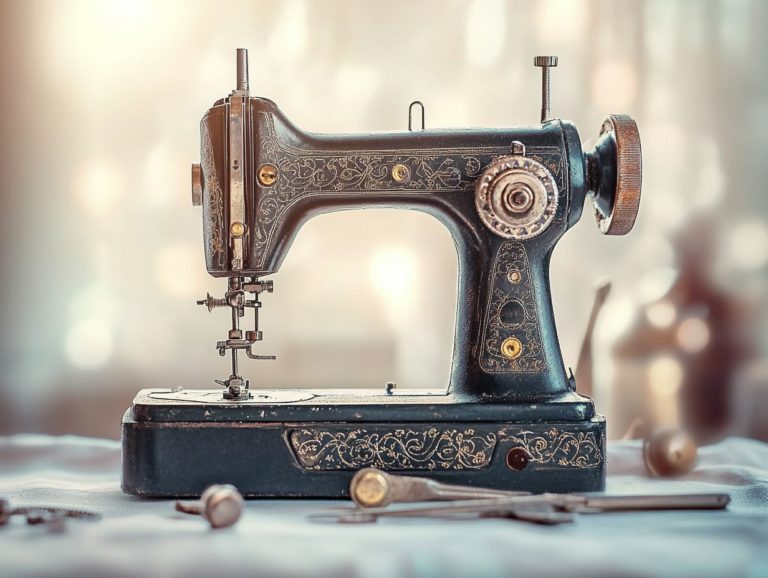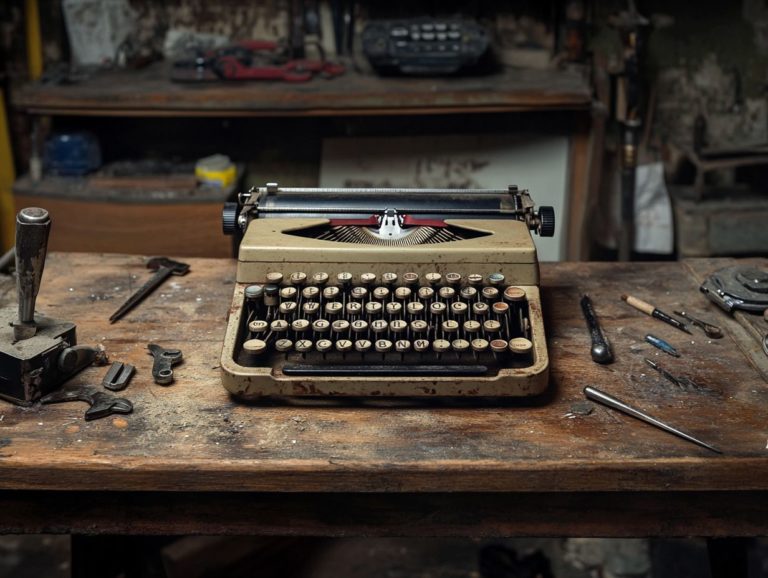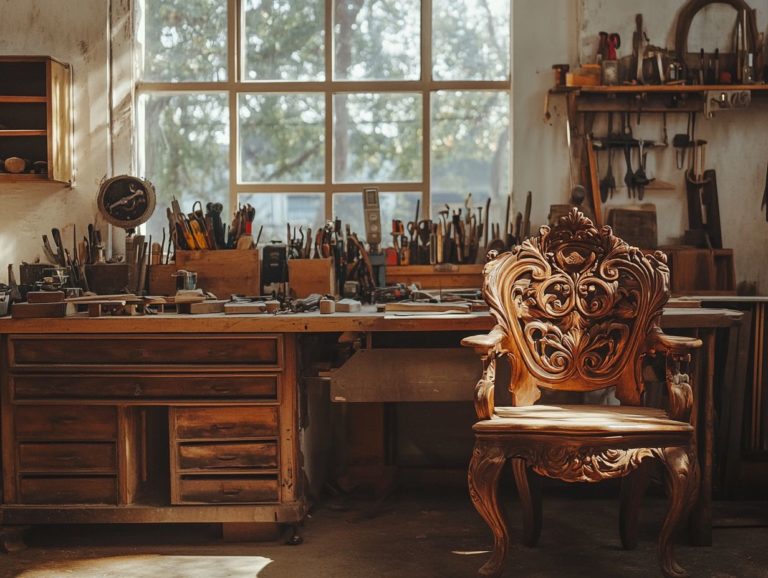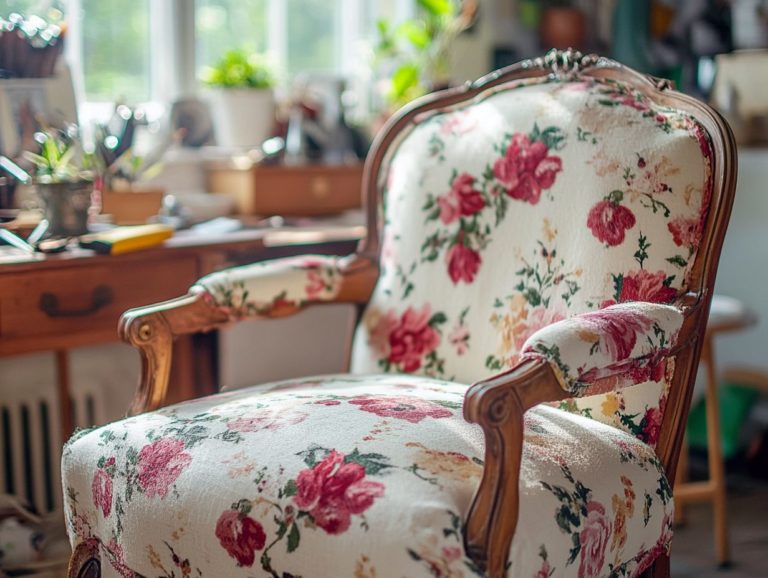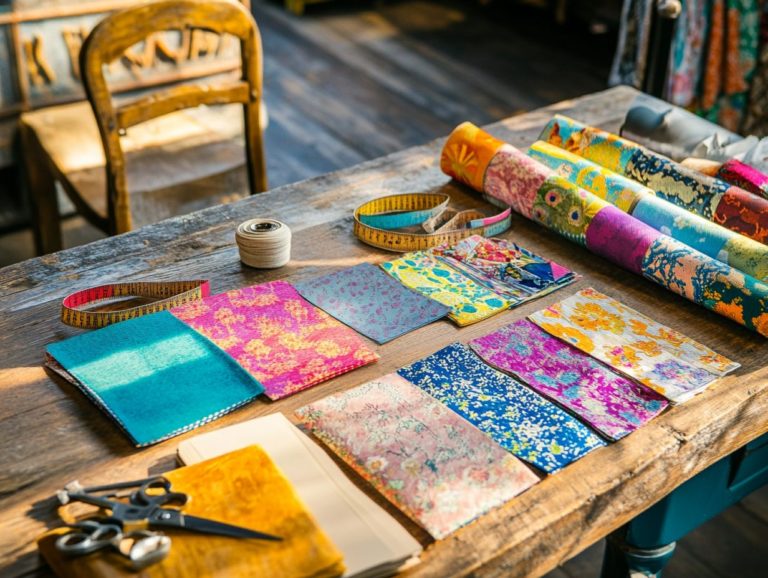DIY Restoration: Cleaning Vintage Fabrics Safely
Cleaning vintage fabrics transcends mere aesthetics; it is a way to keep history alive.
These treasured pieces often hold significant sentimental value, necessitating a careful approach and a bit of expertise.
This article delves into various types of vintage materials, from delicate fabrics that are easy to damage to robust linens, offering important tips for assessing their condition.
You’ll discover safe cleaning techniques, effective methods for removing stains, and best practices for drying and storing, all designed to ensure that your cherished fabrics endure for generations to come.
Contents
- Key Takeaways:
- Common Types of Vintage Fabrics
- Precautions Before Cleaning
- Cleaning Techniques for Different Fabrics and Garments
- Stain Removal for Vintage Fabrics
- Drying and Storage Tips
- Frequently Asked Questions
- Can I use regular laundry detergent to clean vintage fabrics?
- What is the best way to remove stains from vintage fabrics?
- How often should I clean my vintage fabrics?
- Can I wash my vintage fabrics in the washing machine?
- How can I prevent my vintage fabrics from fading?
- Can I use a dryer to dry my vintage fabrics?
Key Takeaways:
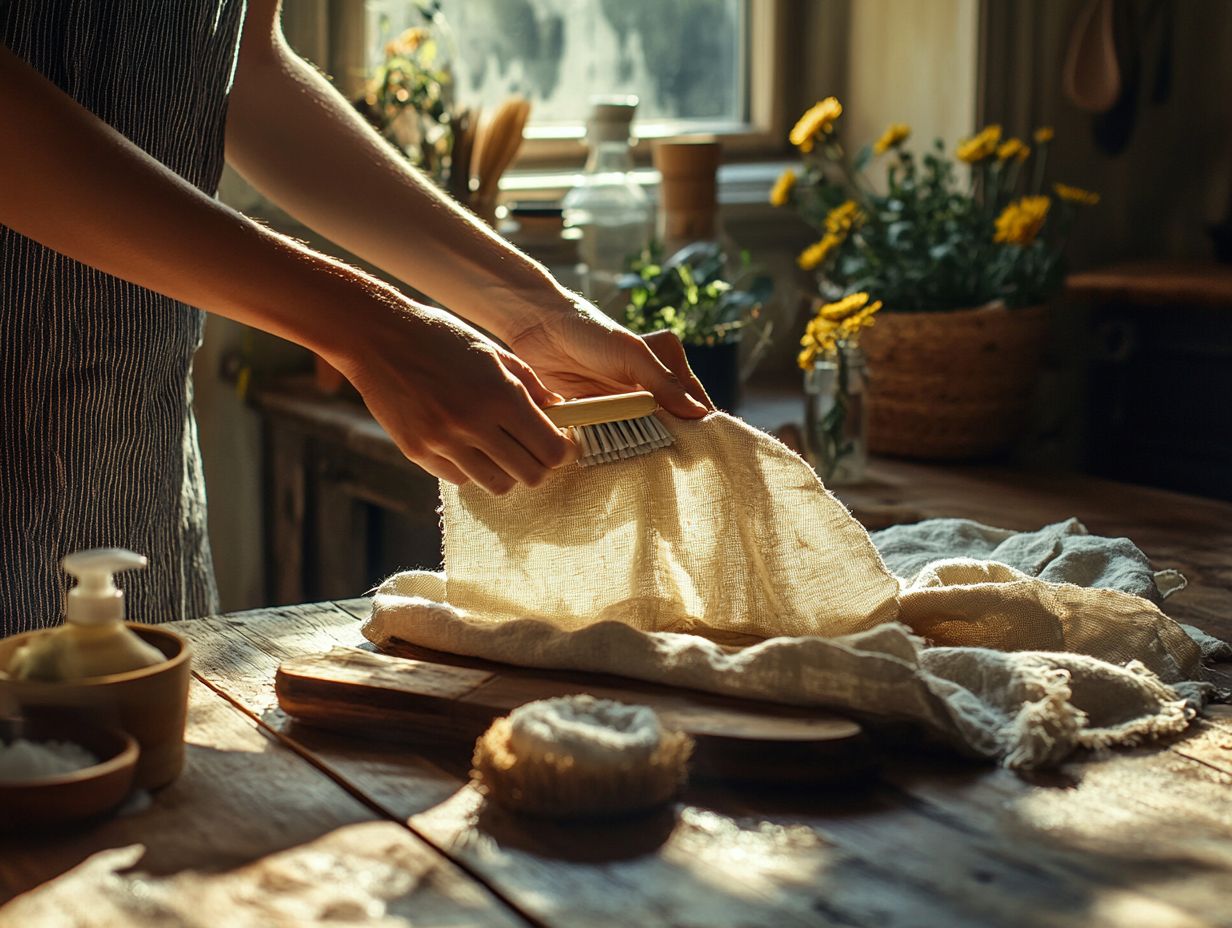
- Take the time to identify the type of vintage fabric before attempting to clean it to avoid causing damage.
- Always assess the condition of the fabric and potential risks before choosing a cleaning method.
- Use gentle and specific cleaning techniques for delicate fabrics that are easy to damage to avoid causing further harm.
Why is it Important to Clean Vintage Fabrics?
Cleaning vintage fabrics is essential not just for preserving their beauty, but also for maintaining their integrity, ensuring that your cherished items stand the test of time for future generations. Over time, dust, moisture, and even stains can accumulate on these delicate linens. If you don t care for them properly, you risk causing irreversible damage to your vintage fabrics.
It’s important to use gentle techniques tailored to different fabric types for both aesthetic appeal and longevity. Vintage fabrics, often crafted from materials like cotton, silk, wool, and rayon, as well as nylon and polyester, each have specific care requirements to prevent deterioration and losing their color, making proper cleaning vital.
Neglecting these responsibilities can lead to fabric degradation, losing their color, and even permanent stains, which will diminish both the value and history of your items. Care tags are invaluable guides, offering instructions tailored to each material s unique needs. Ignoring them could mean the difference between preserving a treasured heirloom and watching it fade away.
By employing the correct cleaning methods, you not only enhance the fabric’s appearance but also safeguard it from harmful elements like mold or pests that can thrive if vintage pieces aren t cared for properly. Therefore, understanding and implementing the right cleaning practices demonstrates a commitment to preserving the rich narratives woven into these timeless treasures.
Common Types of Vintage Fabrics
Vintage fabrics offer a captivating array of materials, each with its own unique characteristics that dictate care requirements and overall aesthetic appeal. From the gentle softness of cotton to the luxurious sheen of silk, the variety in fabric types enhances the allure of vintage clothing and linens.
Wool wraps you in warmth, while polyester boasts remarkable durability, making each fabric distinct in its uses and preservation needs. Grasping these differences is essential for you to effectively maintain and enjoy your vintage treasures, ensuring they retain their beauty for years to come.
Identifying Different Types of Fabrics
Identifying the various types of vintage fabrics is crucial for determining the right cleaning methods and care techniques, as each material comes with its own set of requirements. Cotton, with its breathability and durability, often appears in everyday garments. On the other hand, silk offers a luxurious texture that demands gentle handling. Wool, celebrated for its warmth, can be complex due to its natural fibers, while synthetic options like polyester and nylon bring durability to the table. Rayon, known for its silky feel, also requires careful treatment. Recognizing these fabrics is essential to ensure their proper maintenance.
Beyond material characteristics, vintage fabric identification can engage your senses beautifully. When you touch the fabric, you can glean clues about its weight; a heavy drape might suggest wool or velvet, while a light, airy texture could indicate chiffon or organza.
Visual elements play a vital role, too. Pay attention to the unique patterns and finishes that can hint at the era of production think floral prints for the 60s and bold geometric designs that may trace back to the 70s.
Care techniques vary significantly; gentle hand washing works best for delicate silk, whereas cotton can easily withstand machine washing. This knowledge is vital for anyone who loves vintage pieces.
Don t wait start preserving your treasures today! Your vintage treasures deserve the best care. Start today!
Precautions Before Cleaning
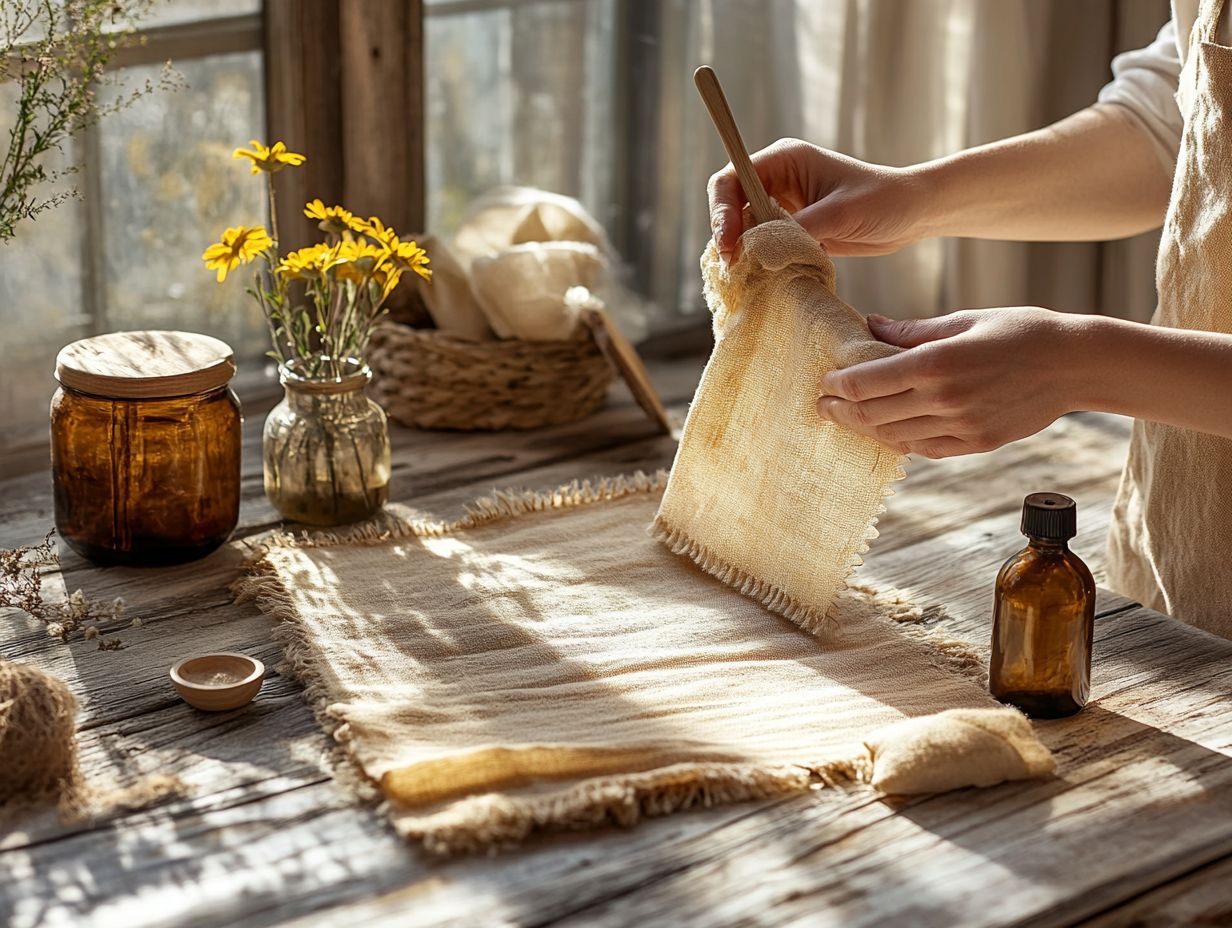
Before you dive into cleaning vintage fabrics, it’s essential to take a few precautions to ensure each item receives the best care. Start by assessing the fabric’s condition. Check for any existing stains and understand the potential risks associated with different ways to clean.
Every piece tells a story; understanding its history is key to successful cleaning! Consult care tags and fabric experts when in doubt to steer clear of any mishaps.
Taking these steps will protect the beauty and history of your treasured vintage pieces.
Assessing Fabric Condition and Potential Risks
Assessing the condition of vintage fabrics is an essential step in your cleaning process. This guides you toward the best approach while highlighting any potential risks. Signs of wear like fraying, discoloration, or stubborn stains demand careful analysis to prevent worsening any existing issues.
For example, delicate silk simply can t handle the same cleaning methods as more robust cotton. Understanding the fabric s history and any previous treatments can help you identify potential risks linked to various cleaning techniques.
As you dive into evaluating vintage fabrics, don t just rely on what you see trust your touch. Gently running your fingers over the surface can reveal its texture and uncover any areas of weakness that might not be immediately visible.
When it comes to cleaning, remember that hand-washing is usually a more favorable option than machine washing, especially for fragile materials. It reduces the risk of agitation that could lead to irreversible damage.
Many vintage textiles may hold environmental contaminants or residues, so choosing your cleaning agents wisely is crucial. Act now to ensure these treasures receive the care they deserve!
Cleaning Techniques for Different Fabrics and Garments
Employing the right cleaning techniques for various vintage fabrics is crucial to ensuring their longevity and preserving their beauty. Each material be it cotton, silk, wool, or synthetics comes with its own unique requirements that dictate the best cleaning methods.
Gentle washes, careful soaking, and thorough rinsing are essential for preserving delicate fibers. Sturdier fabrics can often handle machine washing or dry-cleaning, which is a method using special chemicals instead of water.
By mastering these techniques, you can protect the integrity of your vintage items, ensuring they remain treasured pieces for years to come.
Specific Methods for Delicate and Sturdy Fabrics
Specific methods for cleaning delicate and sturdy vintage fabrics are essential to preserving their unique qualities and ensuring their longevity.
Understanding how to treat these fabrics can significantly impact their condition. Soaking delicate items in lukewarm water for a brief period helps to loosen dirt without risking tears.
When faced with stubborn stains on sturdier materials, pre-treating with a stain remover before machine washing does the trick. While hand washing offers you greater control over the cleaning process, it can be more time-consuming than the efficiency of a machine wash.
Using a mesh laundry bag and selecting a gentle cycle can safeguard heavier fabrics from excessive agitation. Each method has its own advantages and challenges, but choosing the right approach will greatly enhance the lifespan of your treasured vintage pieces.
Stain Removal for Vintage Fabrics

For stain removal on vintage fabrics, you need a careful method to avoid damage while effectively addressing those unsightly marks. You have various cleaning methods at your disposal, from natural solutions like vinegar to commercial products such as OxiClean, each tailored for different stains and fabrics.
Understanding the fabric’s composition, whether it’s cotton, silk, or wool, is crucial for choosing the right stain removal technique. By applying the appropriate method carefully, you can preserve the integrity and colors of your cherished items, especially with the best vintage fabric restoration techniques.
Effective and Safe Stain Removal Methods
Effective and safe stain removal methods for vintage fabrics are essential for maintaining their beauty. Many vintage pieces respond well to natural solutions like vinegar, which can lift stains gently without damaging delicate fibers.
For stubborn stains, OxiClean can be a powerful ally when used correctly, ensuring that colors stay vibrant. Avoid harsh chemicals like bleach unless absolutely necessary, as they can compromise delicate fabrics.
Pay close attention to the specific fabric type when selecting a cleaning method. Materials like silk or satin may react differently to even mild products. For greasy stains, a dash of dish soap can effectively break down oils without harming the fabric. If you’re dealing with vintage textiles, consider looking up how to repair vintage fabrics at home. Always test any cleaning solution on a hidden area first to avoid unexpected discoloration.
While household remedies like baking soda are handy for absorbing moisture and neutralizing odors, commercially available stain removers may offer more targeted action. However, they come with risks concerning fabric safety.
Drying and Storage Tips
Proper drying and storage of vintage fabrics are essential for preserving their quality and extending their lifespan. After cleaning, dry your items away from direct heat and sunlight to prevent color fading and fiber weakening.
Air drying is often the best practice for delicate linens, allowing moisture to evaporate naturally. When storing vintage garments, choosing breathable materials and avoiding plastic is crucial to protect against moisture and pests. For more detailed guidance, check out this how to care for vintage textiles and fabrics.
Proper Techniques for Drying and Storing Vintage Fabrics
Understanding proper techniques for drying and storing vintage fabrics is essential for preserving their longevity and aesthetic appeal. Vintage items often require special attention due to their age and sensitivity.
After washing delicate pieces, air-dry them in a shaded area. This will help maintain their vibrancy while minimizing the risk of color fading. For storage, selecting breathable fabric bags or acid-free boxes is highly advisable.
These options promote air circulation and help prevent moisture buildup, which can lead to mildew or degradation. Using fabric softener during washing can enhance the softness of cotton and wool fabrics.
For items with intricate details or embellishments, gently rolling them instead of folding can prevent unwanted creases and maintain their original beauty. Don t wait! Regularly inspect your vintage clothing for signs of wear and consider using a cleaning fluid designed specifically for delicate fabrics.
Frequently Asked Questions

Can I use regular laundry detergent to clean vintage fabrics?
No, it is not recommended to use regular laundry detergents on vintage fabrics. The harsh chemicals may damage the delicate fibers.
Instead, use a special fabric cleaner like Eucalan, designed specifically for vintage fabrics.
What is the best way to remove stains from vintage fabrics?
The best way to remove stains from vintage fabrics is to use a mild stain remover designed for delicate materials. It is important to spot test the stain remover on a small, inconspicuous area of the fabric first to ensure it does not cause any damage.
You may also consider using a vinegar solution for some types of stains.
How often should I clean my vintage fabrics?
To keep your vintage fabrics looking their best, clean them at least once a year to prevent dirt and dust from building up and potentially causing damage.
If you use the fabric often, wash it more frequently. Always refer to the care tags for specific instructions.
Can I wash my vintage fabrics in the washing machine?
It depends on the condition of the fabric and the washing instructions. If the fabric is fragile or has special decorations, it is best to hand wash it.
However, some vintage fabrics may be able to be washed in a gentle cycle with cold water and mild detergent. Always check the care tags before proceeding.
How can I prevent my vintage fabrics from fading?
To prevent fading, it is important to store your vintage fabrics in a cool, dark place away from direct sunlight.
When cleaning, use a gentle detergent and avoid harsh chemicals or bleach. Rotate the fabric now and then to prevent one side from fading more than the other.
Consider using a gentle wash method for more delicate items.
Can I use a dryer to dry my vintage fabrics?
For the best care, avoid using a dryer on your vintage fabrics! High heat can ruin them. Instead, lay the fabric flat on a towel and let it air dry.
If necessary, you can use a fan to help speed up the drying process. Always ensure the fabrics are completely dry before storing.

